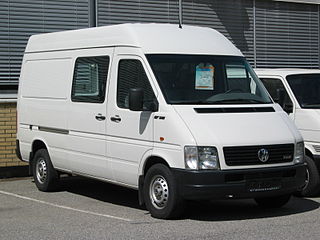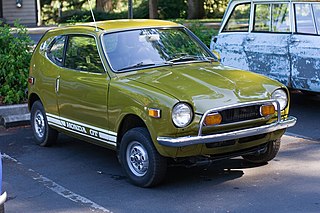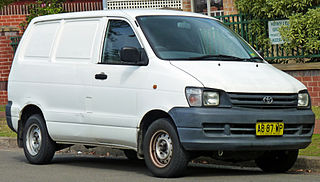
DAF Trucks is a Dutch truck manufacturing company and a division of Paccar. DAF originally stood for van Doorne's Aanhangwagen Fabriek. Its headquarters and main plant are in Eindhoven. Cabs and axle assemblies are produced at its Westerlo plant in Belgium. Some of the truck models sold with the DAF brand are designed and built by Leyland Trucks at its Leyland plant in the United Kingdom.

Leyland Motors Limited was an English vehicle manufacturer of lorries, buses and trolleybuses. The company diversified into car manufacturing with its acquisitions of Triumph and Rover in 1960 and 1967, respectively. It gave its name to the British Leyland Motor Corporation, formed when it merged with British Motor Holdings in 1968, to become British Leyland after being nationalised. British Leyland later changed its name to simply BL, then in 1986 to Rover Group.

The Volkswagen LT is the largest light commercial panel van produced by Volkswagen from 1975 to 2006, before being replaced by the Crafter. Two generations were produced.

The Honda Z is a two-door hatchback kei car/city car manufactured and marketed by the Honda Motor Company, from 1970 until 1974. Exports mostly ended after 1972, when the domestic market models received redesigned pillarless bodywork.

The Volvo 700 series is a range of executive cars produced by the Swedish manufacturer Volvo Cars from 1982 to 1992. The 700 series was introduced in 1982 with the luxurious 760, followed two years later by the lower priced 740 which capitalized on the prestige attained by the very similar 760. The 700 series was then gradually replaced, beginning in 1990, by the 900 series. The 700, designed by Jan Wilsgaard, was originally to have been a replacement for the 200 series, but production of that model continued until the early nineties. The expensive 780, a Bertone-designed coupé version, entered production in 1986 and departed without a direct successor only four years later.

The Daihatsu Hijet is a cab over microvan and kei truck produced and sold by the Japanese automaker Daihatsu since 1960. Despite the similarities between the Hijet name and Toyota's naming scheme for its trucks and vans, the name "Hijet" has been in use for Daihatsu's kei trucks and microvans since 1960, over two decades before Toyota took control. "Hijet", when transliterated into Japanese, is very similar to "Midget", one of Daihatsu's other mini-trucks. According to Daihatsu, the name "Hijet" was created to imply that the vehicle offers higher performance than the Midget. The Hijet competes in Japan with the Honda Acty, Mitsubishi Minicab, Nissan Clipper, Subaru Sambar and Suzuki Carry.

The Volvo Modular Engine is a family of straight-four, straight-five, and straight-six automobile piston engines that was produced by Volvo Cars in Skövde, Sweden from 1990 until 2016. All engines feature an aluminum engine block and aluminum cylinder head, forged steel connecting rods, aluminum pistons and double overhead camshafts.

The Toyota Dyna is a light to medium-duty cab over truck for commercial use. In the Japanese market, the Dyna is sold alongside its twin called the Toyoace. The Toyoace was a renaming of the Toyopet SKB Truck as a result of a 1956 public competition with 200,000 entries. "Dyna" is short for dynamic.

The Volvo FL is a series of trucks manufactured by Volvo Trucks. It was introduced in 1985 and has remained in production ever since, in a variety of different models of different weight ratings. It has been used in a variety of different roles aside from a truck, including as a fire engine.
The Mitsubishi Town Box is a kei car and minivan produced for the Japanese domestic market (JDM) by the Japanese automaker Mitsubishi Motors. It was initially available with the alloy-headed 4A30 657 cc inline-four engine, but switched to the 3G83 659 cc straight-three engine in 2002. From June 1999 until August 2001, a slightly larger version of the same vehicle powered by a 4A31 1.1 L straight-four, the Mitsubishi Town Box Wide, was also available. The first generation Town Box was discontinued in November 2011, ending the twelve-year production run. The nameplate returned in February 2014 on a rebadged version of the Suzuki Every Wagon.

The Hino Ranger is a medium or heavy duty commercial truck produced by Hino Motors since 1964. In the domestic market, its principal competitors are Isuzu Forward, Nissan Diesel/UD Condor and Mitsubishi Fuso Fighter.

The Isuzu Faster is a pickup truck that was manufactured and marketed by Isuzu between 1972 and 2002 over three generations. The Faster was succeeded worldwide by Isuzu D-Max, except in Japan and North America.

The Toyota LiteAce and TownAce are a line of light commercial and derivative passenger vans produced by the Japanese car manufacturer Toyota. These vehicles originally utilized the cab-over-engine configuration, although since 1996 a semi-cab-over arrangement has featured instead. The LiteAce launched in 1970 as light-duty truck, with commercial and van/wagon body variants added in 1971. In 1976, Toyota released the larger TownAce van/wagon that derived from the LiteAce; a TownAce truck arrived later in 1978. Between 1982 and 1992, the series accommodated the MasterAce Surf—an upscale TownAce passenger wagon.

The Iveco Daily is a large light commercial van produced by the Italian automaker Iveco since 1978; it was also sold as the Fiat Daily by Fiat until 1983. Unlike the more car-like unibody Fiat Ducato, the Daily uses a separate ladder frame typical of heavier commercial vehicles. The Iveco Daily is produced at the Iveco Suzzara plant, near Mantova in Italy, where Iveco has recently made substantial investments to renew the production lines.

The YD engine is a 2.2 and 2.5 L inline-four diesel engine from Nissan. It has a cast-iron block and aluminium head with chain driven twin overhead camshafts. The engine shares much of its architecture with the QR petrol engine.

The international or global version of the Ford Ranger is a series of pickup trucks sold by Ford under the Ranger nameplate mainly for markets outside the Americas since 1998. The 1998–2011 international Ranger models were jointly developed with Mazda, sharing the same assembly line and most parts with the Mazda B-Series and its successor, the Mazda BT-50. It is a successor of the Ford Courier as the Mazda-based Ford global pickup. The vehicles are mainly produced in the manufacturing plants in Rayong, Thailand and Pretoria, South Africa.

The Mahindra Bolero is a SUV produced by Mahindra & Mahindra.

The Club of Four was an alliance of four European truck manufacturers: Saviem, Volvo, DAF, and Magirus-Deutz.

The DAF F241 series is the name of a cab used on a series of heavy-duty, mostly long distance trucks produced by the Dutch manufacturer DAF from 1973 until 1994. They are better known as the DAF 2800, 3300 and 3600. The cab was a wider development of the F218, DAF's first tilt cab placed on among others 2500. The names reflect the cab width in centimetres, at 218 and 241 cm respectively. The cab was also used by Hungary's RÁBA for various applications.






















